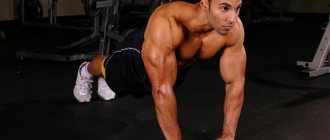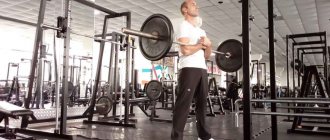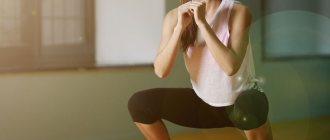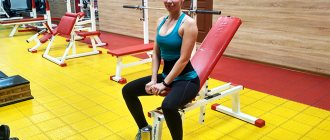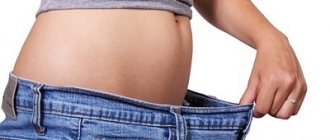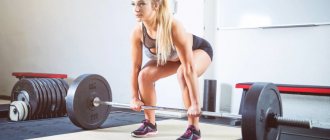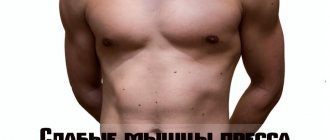In Sergei Bubnovsky’s book “50 Essential Exercises for Health,” these exercises are suggested for people with hypertension and other diseases of the cardiovascular system to normalize blood circulation. However, each exercise has a lot of “side effects” - from strengthening the abdominal muscles, arms and legs to the prevention of herniated intervertebral discs and osteochondrosis. Perhaps this is the kind of gymnastics that should be included in your daily set of exercises first.
Kneeling push-ups
The work of the muscles of the thoracic spine and the girdle of the upper limbs normalizes the work of the pulmonary and systemic circulation. And the diaphragmatic exhalation “Ha-a” while extending the arms allows you to reduce intrathoracic, intracranial and intra-abdominal pressure. It has no contraindications.
I.P. Lying on the floor, rest on your knees, arms bent at the elbows. As you exhale “Ha-a,” we straighten our arms and keep our body straight.
Weakened patients (as I call only patients with chronic ischemic heart disease - HIHD) can start by doing push-ups on a bench while kneeling. The pause between push-ups is 30–45 seconds for the weak, 10–20 seconds for the relatively healthy. Take your time to increase the total number of push-ups, starting with 5-10 repetitions in two or three sets. Aim for 100 push-ups in one session (10 sets of 10 push-ups).
Squats
This exercise is basic for the leg muscles, the condition of which, as is known, depends on the condition of the vessels of the lower extremities. Thanks to the regular work of these muscles, the speed and volume of blood flow in the systemic circulation is restored, and the return of venous blood from the legs to the heart is improved. Contraindications: deforming arthrosis in the hip and knee joints.
I.P. Standing facing a fixed support, to which the rubber shock absorber is fixed, at such a distance that the shock absorber is tensioned. Feet shoulder width apart. The back and arms are straight, holding the bar at chest level. Try to squat at least 90 degrees (thigh to floor) for the first 10–20 movements, bending your leg at the knee joints, keeping your back straight.
Extend your legs while exhaling “Ha-a.” Perform at least 10 repetitions per set. Try to gradually increase the number of approaches. But do it slowly, for example, add one approach every 2-3 weeks.
Push-ups and squats are strength exercises that help restore the speed and volume of blood flow, but in order for the vessels to be ready to regularly pass the necessary volumes of blood through themselves, aerobic exercise is needed. These include, for example, fast walking.
What do squats do for the heart?
Physical training
Squats: 1st floor of the body. This means performing strength exercises for the legs with the involvement of the muscles of the foot, lower leg, thigh, and buttock. They are performed accompanied by a diaphragmatic1 exhalation “haaa”, that is, an active exhalation with each extension of the legs (that is, when standing up). This is not a burden on the heart, but a help to it. That is, the “peripheral heart” picks up the arterial wave of blood and delivers it back to the heart while maintaining the required speed and volume of blood flow. Nature has not come up with other mechanisms for maintaining normal blood flow. Therefore, weak legs mean a weak heart! Squats are one of the main exercises that help the heart, and in case of heart disease (coronary heart disease, arrhythmia) - its medicine. Pills prescribed at the first signs of heart failure, reducing so-called physical activity (I never understood such a recommendation) “corrupt” the body, simultaneously promoting muscle atrophy. Pills are doping, a whip for a decrepit horse. As an example, I usually give two squat techniques: without support (arms up) and with a fixed support (Fig. 7, 8). Contraindications to squats are coxarthrosis of the hip joints (dysplastic or deforming) and grade III-IV deforming gonarthrosis (damage to the knee joints). The truth, as I managed to find out at my seminars, is
There are many incorrect diagnoses by radiologists, and on the part of arthrologists (doctors who treat joints) there is clearly insufficient functional diagnostics of joints, that is, a diagnosis of “arthrosis” is made where exactly functional diagnostics (carried out in Centers for Modern Kinesitherapy) do not detect arthrosis. Why? I'll explain. The patient complained of pain in the hip joint - here you have coxarthrosis. The picture is “clean”, the joint is intact and rotates. Nevertheless - coxarthrosis; a person complains of pain in the joint area... Often doctors do not even check the function of the joint. Maximum - tap with a hammer on the exit points of the nerve endings. The same picture applies to the knee joints. According to our operational data, up to 70% of people who have a diagnosis of coxarthrosis or gonarthrosis in their medical history actually do not have it. In such cases, the cause of joint pain may be osteochondrosis of the lumbar spine. But in any case, it is necessary to carry out the so-called functional differential diagnosis, which, unfortunately, specialists, as a rule, do not carry out. I receive a lot of letters about this. They send pictures. I want to immediately warn everyone: it is not possible to make a final diagnosis using images, that is, remotely. Only after myofascial diagnosis. It is better to contact the nearest Dr. Bubnovsky Center (addresses are on the website www. bubnovsky.org). Unfortunately, many of my readers do not read the recommendations carefully, begin to squat in the presence of true deforming arthrosis of the lower extremities, and instead of helping the heart, they “receive” increased pain in the legs. And more about squats. Personally, I prefer to do squats with a straight back, holding on to rubber shock absorbers attached to a fixed support (Fig. 9) or simply to a wall bars. This allows you to turn off your back muscles and turn on only your leg muscles. I also advise you to squat in the sea, standing deep in the water (hands on the water), as well as in the pool at the side, holding the handrails. Squats in water can be done by people even with not entirely healthy hip joints, since in a liquid environment gravity is reduced and the body weight does not “press” on the joint surfaces.
| Squats can replace running, cycling, swimming, walking. |
Let me remind you again. The main condition when squatting is to bend your knees and straighten your legs and exhale “haa”. Try squatting 10 times first. Bend your knees to the angle that your joints and muscles allow. Usually, to begin with, you should not lower your thigh below your knee. It happens that the leg muscles are so weakened that a person literally sinks to the floor in a squat and cannot get up
Maybe. In this case, it is enough that the angle between the thigh and lower leg is 90 ° (thigh parallel to the floor). If the next day there is no muscle pain, you can increase the series of squats to two or three, that is, increase the total number of repetitions to 20-30. I don’t recommend doing more than three series of 10 squats in the first days. This applies to people who are physically weak. Therefore, it is necessary to focus on your condition that arises after the first days of training, primarily on muscle pain and heart rate. In addition, in the first days, blood pressure and even body temperature may increase. These are normal adaptive reactions. The body must be trained gradually and patiently. Take your time to increase your exercise numbers. Treat yourself and your condition soberly and adequately. No need for fanaticism. Raisa Nikolaevna achieved 120 squats in one session in combination with other exercises. If she did only squats, she could easily increase their number to 400 in 30-40 minutes. Squats can be performed daily in small series from 30 to 50 - three times 10 squats, five times 10 squats, etc., or every other day - from 50 to 150. Squats are simply necessary for those who sit a lot (office workers, accountants , drivers, etc.).
| Squats are simply necessary for those who sit a lot (office workers, accountants, drivers). |
Squats can replace running, cycling, swimming, walking.
One of the physical indicators of sufficient load when squats in healthy (young) people is a burning sensation in the muscles of the anterior thigh (quadriceps femoris). But this sign is for those who are prepared and can occur at the end of each series of exercises1. It is possible to pre-
in this case, overcome the “burning” in the muscles until they “failure” - for those who are very prepared, that is, to the point where it is impossible to continue this exercise. The interval between series is 10-20 seconds, but no more. After squats, I recommend stretching the muscles of your legs and back. Any stretching after performing strength exercises is necessary so that the muscles do not hurt the next day. If you decide to finish the session with only squats, be sure to immerse your feet in cold water for 5-10 seconds upon completion. Personally, I like to sit in a bath of cold water. Then you need to rub your feet dry with a hard towel. Don't forget to rub the oil (cream) into your feet (so that your skin doesn't dry out). After exercise, the cosmetic effect of the cream rubbed into the skin of the legs is much higher, since the working skin better absorbs the microelements it needs from the cream (oil).
| Back | Table of contents | Further |
Walking (walk)
It is better to practice walking in the park, on dirt paths (if on asphalt, then shoes should have good soles - sneakers, for example). If this is not possible - for example, in winter when there is ice - then you can walk at home. This will require a step or step. Walk for at least 20 minutes, monitoring your pulse - heart rate (HR). A level of 140–145 beats per minute is safe for the cardiovascular system.
Gradually increase the speed and number of meters (kilometers). A good figure is 3–5 km 2–3 times a week. If you walk at home - 20-25 minutes at a pulse of 140-145 beats per minute 2-3 times a week.
Movement is life! Dr. Bubnovsky's original method for combating hypertension
Hypertension or hypertension is a chronic increase in blood pressure. The disease affects almost 30% of adults under 65 years of age.
After 65, manifestations of hypertension are observed in every second person. Hypertension is considered the most common disease of the cardiovascular system.
In an adult, the norm for blood pressure is considered to be 120 over 80. Small deviations are allowed, which may be the individual norm. To establish the presence of hypertension, it is enough to systematically measure blood pressure using a tonometer.
As a preventative measure, this should be done by everyone after reaching 30 years of age. Today we will consider the treatment of hypertension using the Bubnovsky method.
The symptoms of hypertension are very diverse.
Patients complain of headaches, pain in the heart, darkening and black spots in the eyes when suddenly rising from a bed or chair, nausea, vomiting, general weakness, manifestations of sclerosis, swelling of the body, red spots on the skin and insomnia.
This is just a list of the main signs of hypertension; each disease can manifest itself individually.
Among the causes of the disease, medical experts identify disorders of the nervous system, hormonal changes, excess weight, atherosclerosis, physical inactivity, other chronic diseases, a sedentary lifestyle, excessive salt consumption, alcoholism, diabetes, hereditary predisposition, smoking, high cholesterol in the blood.
Blood circulation in the body is life itself. As long as all organs are supplied with oxygenated blood, the body functions normally.
Increasing pressure is essentially a defense mechanism of the body: it needs to push the required amount of blood even if any obstacles arise on its way. The most common causes of increased blood pressure are disturbances in the functioning of blood vessels.
If the walls of the vessel cannot contract normally, blood pressure increases. There can be many reasons: the formation of atherosclerotic plaques, the loss of elasticity by the walls of blood vessels, the formation of blood clots.
Hypertension is dangerous due to such consequences as strokes, myocardial infarction, circulatory disorders of certain organs, erectile dysfunction, thrombosis, complications of diabetes mellitus, blurred vision, the development of atherosclerosis and heart failure.
When the development of hypertension reaches its maximum, the patient experiences a hypertensive crisis.
In addition to the main symptoms of hypertension, at the time of the onset of a hypertensive crisis, patients complain of severe headaches, impaired coordination and speech, fainting, and increased sweating.
Treatment of hypertension often comes down to taking a course of medication and radical lifestyle changes: quitting smoking and drinking alcohol, avoiding fatty, salty, sweet, fried and spicy foods, frequent walks in the fresh air, moderate physical activity, regular sleep, recovery nervous system.
There are also a number of non-standard, but no less effective methods. Bubnovsky proposed special exercises to lower blood pressure as a treatment.
Sergei Mikhailovich Bubnovsky introduced a fundamentally new approach to the treatment of hypertension. His therapy system is based on a combination of medical and advisory assistance and a number of health procedures. This technique originates in kinesitherapy.
Sergei Mikhailovich Bubnovsky - author of the method of treating hypertension through exercise
Kinesitherapy is literally translated as treatment through movement. Patients will be able to forget about unpleasant procedures, injections, pill packs and operations. The doctor prescribes courses of massage and proper exercise, with an emphasis on certain areas using special simulators. The exercises can be repeated at home, but strictly following the recommendations of a specialist.
Almost half of patients with hypertension suffer from the disease due to poor vascular condition. Dr. Bubnovsky suggests restoring vascular tone with a series of simple exercises.
For tangible results, you just need to maintain the regularity of your workouts, and don’t give up on a set of exercises in the middle.
You always need to start small. Especially if the patient has not previously tortured himself with physical activity. You need to get used to the idea that at first the muscles will ache and that during the first week you will have to overcome not only the pain, but also yourself.
Squats are considered an excellent way to combat heart muscle diseases. This type of physical exercise does not add additional stress to the heart, but rather has a beneficial effect on its functioning. For the exercise, hypertensive patients will only need a hard surface under their feet and a wall for support.
Principle of exercise:
- the patient places his feet shoulder-width apart and straightens his shoulders;
- your back should be straight. This is important, if you can’t straighten your back on your own, you need to lean against the wall;
- for those who want to add strength to themselves, you can pick up a small weight;
- At the very beginning, you should not lower your hips below your knees. This applies to those whose muscles have been in a state of relaxation for too long;
- if it is too difficult to rise, the patient is advised to place a chair or other support for the arms in front of him and help the leg muscles while lifting.
You need to perform at least 10 squats in one approach. There should be about five such approaches per day. Some people stick to a schedule of exercise every other day. Such patients need to perform up to 150 squats in two days, with the same approaches 10 times. Dr. Bubnovsky advises increasing the number of approaches gradually: one every two to three weeks.
Squats can also be performed using a rubber shock absorber attached to a fixed support.
The patient clings to the shock absorber with his hands, which should be as tight as possible.
You cannot spread your arms to the sides. The patient begins to squat: back straight, knees at an angle of 90 degrees, arms extended and tense.
Push-up exercises may seem like an insurmountable barrier for most. In fact, with the right approach, almost anyone can handle this type of training.
Principles of exercises:
- for patients who are no strangers to arm training, it is enough to take a lying position on your stomach with emphasis on your knees and perform 5 to 10 push-ups;
- for those who find it difficult to perform even one full push-up from the floor, a bed or bench is suitable. You need to put your hands on it, thereby reducing the load on them, and try to do 10 push-ups. You can even kneel;
- the break between push-ups should not take more than 10 seconds;
- for each approach you need to perform 10 push-ups;
- each patient should strive to complete 10 approaches per day, i.e. 100 push-ups a day.
He leans his back against the fitball, thereby relieving the load from the spine. Legs are bent at the knees and spread shoulder-width apart.
The patient holds special fastenings in his hands on which the load hangs. As you exhale, you need to put your arms forward.
The number of repetitions should vary from 10-15 to 20-25. Can be divided into several approaches.
It is better to practice walking outdoors on dirt paths or forest paths.
For asphalt surfaces you will have to purchase special shoes. If there are significant obstacles to walking outdoors (cold or bad weather), you can also walk at home.
During exercise, it is important to measure your heart rate every 10 minutes. The norm in this case is 140-145 beats per minute. If the number of blows is significantly higher than the permissible norm, then the exercises should be stopped immediately.
To begin with, it is better to walk for 20-25 minutes. Gradually, the training time should be increased. The distance traveled should also be increased to 3-4 km. The frequency of training should be 2-3 times a week.
This type of abdominal exercise has no contraindications and will help not only improve your health, but also get rid of belly fat.
The patient assumes a lying position. His legs are secured to the machine or wall with a special rope/chain.
With his hands he holds onto the handles of the support. In the gym these are the handles of a special exercise machine; at home you can use a cabinet or wall instead.
Then the patient raises his legs and pulls his knees towards his chest. You need to do at least 20 repetitions per day. You can split the exercise into two sets of 10 repetitions each.
Hypertension and sports with Bubnovsky:
Dr. Bubnovsky’s set of exercises will help patients stabilize and accelerate blood circulation in the body, normalize the functioning of the heart muscle, strengthen the walls of blood vessels and increase their elasticity, train muscles, improve the condition of the musculoskeletal system, get rid of excess weight, increase endurance and overall tone of the body.
Breathing exercises for hypertension according to Bubnovsky also help to normalize the condition. The popular Latin expression “A healthy mind in a healthy body” suits Dr. Bubnovsky’s method perfectly. After all, his therapy is based on movement, and movement is life.
How to beat HYPERTENSION at home?
To get rid of hypertension and cleanse blood vessels, you need.
Sources:
https://zdorovje-usilievoli.ru/chto-dayut-ezhednevnyie-prisedaniya/ https://www.aif.ru/health/secrets/lechebnaya_gimnastika_prisedaniya_dlya_trenirovki_sosudov https://gipertonia.pro/lechenie/uprazhneniya-po-bubnovskomu.html ]]>
Post Views: 1,388
Press forward
The exercise replaces push-ups and is suitable for anyone, even physically weak and/or elderly people. Refers to strength exercises. It is also useful for COPD. It has no contraindications.
I.P. Sitting with your back to the machine, rest your back on the fitball. While exhaling “Ha-a”, perform a forward press of weights fixed to the lower blocks of the machine.
There is no need to rush to increase the weight and number of episodes. Monitor your heart rate response to exercise. It should not exceed 140–145 beats per minute after completing the exercise.
Half birch
The effect of this exercise is hidden in the anti-gravity effect on the vessels of the brain (legs above the head), which helps improve blood supply to these vessels. Exhalation “Ha-a” relieves intrathoracic, intra-abdominal and intracranial pressure. It has no contraindications.
I.P. on the floor, head to the counter, hands resting on the base of the machine. Raise your legs to a 90-degree angle above the floor so that your lower back lies on the floor. Feeling the tension in the back surface of the muscles in the legs, we slightly lift the pelvis off the floor, but do not stand on our shoulder blades.
It is important to select a weight at which you can comfortably, without much strain, perform at least 20 repetitions in one series.
In this version, the exercise is safe even with high blood pressure and allows you to fight not only blood pressure, but also osteochondrosis of the lumbar spine.
Advantages of treating hypertension according to Bubnovsky
The Bubnovsky method of treating hypertension has a lot of advantages, the main one of which is the ability to minimize or completely eliminate often expensive drug therapy. In other words, Bubnovsky offers exercises that are quite accessible and suitable for everyone, which, in addition to stabilizing blood pressure, help:
- relieve nervous tension;
- increase the body's protective properties;
- strengthen the heart and blood vessels;
- slow down the development of atherosclerosis;
- get rid of chronic fatigue.
To reduce pressure, the patient needs to correctly perform each movement and correctly follow the sequence of exercises. After all, for people suffering from arterial hypertension, one must always remember that correct movement heals, and incorrect movement can only worsen the condition and even provoke a surge in pressure.
Press
A wonderful exercise from a series of power aerobics that helps get rid of abdominal fat, restores the anatomical bed of internal organs and relieves pain in the lumbar spine due to herniated intervertebral discs. It has no contraindications.
I.P. Lying on your back, with your feet towards the counter, with your hands holding on to any fixed support (for example, a wall bars). The legs are fixed to the upper block of the exercise machine. As you exhale “Haa,” we pull our knees towards our stomach. We do 19-20 repetitions daily.
Alternatively, you can do it without weights. That is, the legs rise due to the strength of the abdominal muscles.

